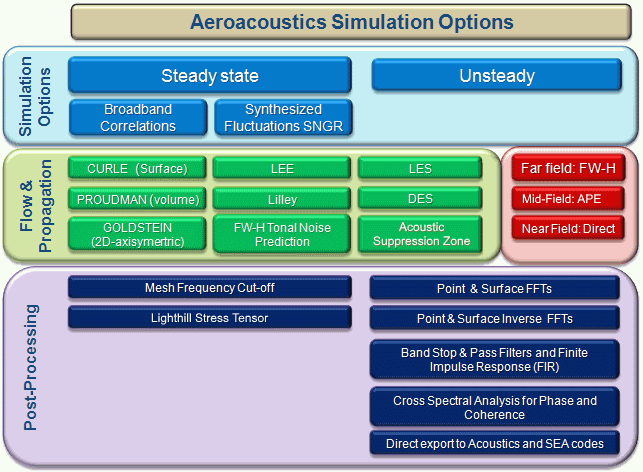How Do I Conduct an Aeroacoustics Analysis?
Simcenter STAR-CCM+ offers a hierarchy of models to conduct an aeroacoustics analysis.

The physics in aeroacoustics are inherently transient and ultimately, must be solved using transient calculations. The computational run times that are associated with such simulations are high. As such transient simulations take a long time to run, optimize the mesh and settings so that you only capture noise sources and frequencies that are relevant to your analysis. An initial steady state analysis provides you with the data for optimizing the mesh and settings.
In steady state analysis, there are two forms of aeroacoustic modeling available:
The first category relates to models that provide aeroacoustic source information through correlations. These models are based on the assumptions implicit to RANS turbulence modeling. They are termed Broadband Noise Source Models and can be attributed to the classical aeroacoustic categorization of dipoles and quadrupoles in shear and jet flows. They are strictly applied to turbulence-generated flow-noise--they do not apply to noise associated with large-scale flow features, such as vortex shedding. For turbulence generated noise, they will:
- Identify the location of flow generated aeroacoustic sources.
- Approximate the associated sound power or dB level.
They provide a reasonable basis on which to:
- Compare one component design with another.
- Decide where to apply mesh refinement ahead of a well-qualified transient calculation.
You can further qualify the suitability of the mesh ahead of a transient calculation by analyzing the frequency that the mesh can resolve. The suitability analysis determines where, and by how much, the mesh must be refined to capture up to the desired frequency. The resolvable frequency is deduced from the mesh frequency cutoff scalar function. If, for example, the function value shows 1 kHz and you want to resolve up to 2 kHz, then refine the mesh a factor of two.
The second category relates to synthesization of turbulent perturbations from the steady state using Synthesized Fluctuations SNGR. The modeled turbulence kinetic energy and length scales are used to create synthetic fluctuations in pressure and velocity through assumption of the turbulent energy spectrum and wave number decomposition. The fluctuations may then be output directly for use in acoustics propagation codes.
After you have optimized the steady state model for an aeroacoustics simulation, you can use it to initialize the transient simulation.
Recommended Analysis Procedure
Set up aeroacoustics simulations as three-dimensional cases. Use compressible flow rather than constant density. Then use the following steps:
- Set up and run the case in steady state mode using a relatively coarse mesh to optimize the case for aeroacoustics. Use the broadband noise source models to identify where to refine the mesh. Use the mesh frequency cut-off scalar function to judge the required size of the cells in the source region.
- Load the case set up in Step 1. Refine the mesh using information from the broadband noise models and the mesh frequency cut-off scalar function. Run the case again in steady state mode, restarting the solution from that of Step 1.
- Load the case set up in Step 2 and modify it to be a transient simulation with an appropriate time-step. Choose LES-based or DES-based turbulence modeling and restart the solution from that of Step 2.
To be able to post-process Lighthill Stress Tensor field functions, select the Lighthill Stress Tensor.
For far field propagation analysis, use the Ffowcs Williams-Hawkings (FWH) model.
- Run the simulation.
Guidelines
See Guidelines for Aeroacoustics Calculations for guidance on how best to apply the aeroacoustics models to your applications.